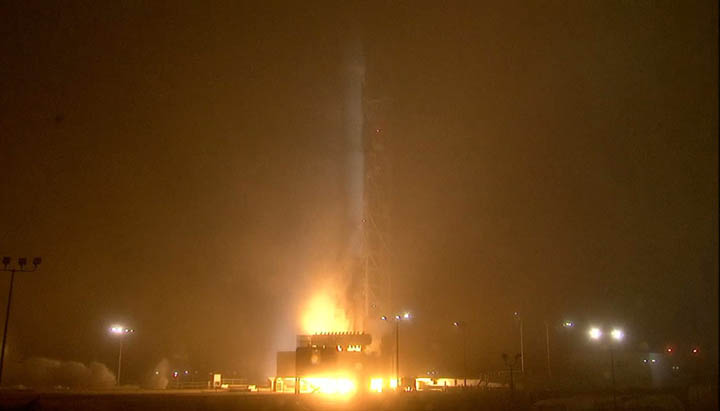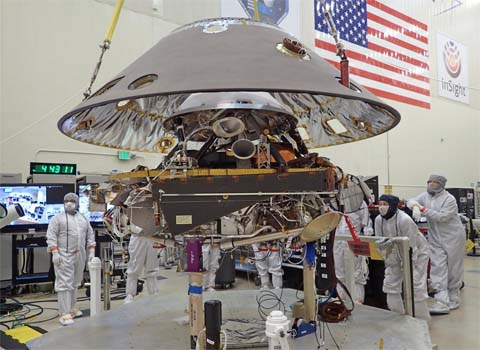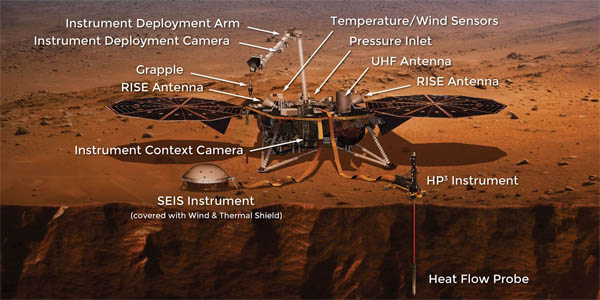Rising with its rocket through thick fog from Vandenberg Air Force Base in California, NASA's latest mission intends to probe deeply into Mars and decipher how it formed.

NASA
NASA made history early this morning, when its InSight spacecraft became the first interplanetary spacecraft ever launched from Vandenberg Air Force Base on the California coast.
But despite intense anticipation, virtually no one saw the Atlas V rocket's on-time liftoff at 4:05 a.m. PDT. By the time the countdown reached T=0, fog had rolled off the Pacific coast in thick waves that completely blanketed the fiery departure from view. Even cameras positioned right next to launch pad barely revealed the towering United Launch Alliance rocket as it rose into the night. Let's call this one a picture-imperfect launch.
Unfazed by the cool, damp conditions, however, the booster and its payload soared southward over the Pacific Ocean. The vehicle's Centaur second stage first fired to propel InSight into a temporary polar orbit and then again to push it past escape velocity and into interplanetary space. Less than 85 minutes after leaving Earth, the spacecraft was speeding toward Mars.
The launch from California, instead of from the more familiar surroundings of Cape Canaveral, became possible after the mission team opted to use a potent Atlas-Centaur launch vehicle, which provided more than enough thrust to offset the velocity boost (due to Earth's rotation) that rockets fired eastward from Florida gain.

NASA / JPL / Lockheed Martin
If all continues to go well, InSight arrives at Mars 6½ months from now, on November 26th, after an interplanetary cruise of nearly 500 million km (300 million miles). Rather than fire rockets to slip into orbit, the spacecraft will make a direct descent to the planet's surface. Along for the ride with InSight are two technology-demonstration microsatellites, dubbed Mars Cube A and B, that popped free soon after the Centaur's shutdown and will fly past the planet late this year.
The spacecraft's name is a "backronym" that stands for Interior Exploration using Seismic Investigations, Geodesy, and Heat Transport. Prime contractor Lockheed Martin Space modeled the spacecraft after the design of NASA's Phoenix lander (which dropped near the Martian north pole in 2008) with upgrades inherited from the MAVEN orbiter.
InSight will reach the surface about 6 minutes after entering the Martian atmosphere using, as Phoenix did, a combination of aerodynamic drag, parachutes, and radar-triggered thrusters. However, compared to Phoenix, InSight is more massive (358 kg or 789 pounds), arrives at higher velocity (6.3 km per second or 14,100 mph), and has a higher-elevation landing site (so there's less atmosphere to slow its speed).
InSight's Focused Payload
This is a mission that has been three decades in the making. Planetary scientists have longed for a chance to probe the deep interior of Mars — a planet that's midway in mass between the Moon and Earth. Its surface geology, scrutinized by a score of orbiters and landers to date, tells only part of the Martian story.
"We really don't know anything if we don't know about the interior," explains principal investigator Bruce Banerdt (Jet Propulsion Laboratory).
To understand the circumstances of the Red Planet's formation — its bulk composition and the size of the eventual core, mantle, and crust — requires the kind of dedicated geophysical investigation that Banerdt first conceived in the late 1980s — and that InSight will soon conduct. "Mars is overdue for a checkup," quipped one of JPL's public-affairs specialists, and InSight will be "checking the planet's pulse, reflexes, and temperature."

NASA / JPL
Here's a rundown on the lander's trio of key instruments:
Seismic Experiment for Interior Structure (SEIS): Geophysicists expect that Marsquakes occur fairly often, and the SEIS instrument will detect those with exquisite sensitivity. It can record ground displacements as small as 2.5 × 10-11 m — smaller than the diameter of a hydrogen atom. These vibrations can arise in the crust in two main ways, explains investigator Mark Panning (JPL): from tidal forces exerted by the satellite Phobos or from compressional stress as the planet continues to cool and shrink in volume.
Typically, it takes three widely separated seismometers to pinpoint the location, depth, and strength of a quake. But SEIS compensates for being a "one-station network" by measuring the various arrival times of a quake's primary and secondary waves as they travel through and around the planet (and perhaps as they lap around the planet a second time). By recording enough of these deep-seated disturbances — along with those triggered by meteorite impacts — the team should determine the size, composition, and state (liquid vs. solid) of the Martian core.
France's national space agency, Centre National d'Etudes Spatiales (CNES), led the consortium of researchers in the U.S, U.K, France, Switzerland, and Germany that provided SEIS. Once InSight's robotic arm places SEIS on the ground, it will then cover the instrument with a protective dome to insulate it from wind and day-night temperature extremes.
Heat Flow and Physical Properties Probe (HPPP or HP3): This instrument will drive a spear-shaped "mole" up to 5 m (17 feet) deep in the Martian soil, dragging along a cable studded with a series of temperature sensors. Its goal is to calculate the rate at which heat is escaping from the planet's deep interior.
"Knowing the interior structure is important," explains HP3 investigation leader Tilman Spohn (German Aerospace Center), "but planets are engines that use their internal heat to do geology on the surface." This experiment, he says, will "determine the rate at which the engine is running."
About 40 cm (16 inches) long and 2.7 cm (1 inch) across, the mole will burrow down 1 mm at a time by repeatedly cocking and releasing a spring-loaded hammer. It should reach its planned depth over the course of a month, after making 5,000 and 20,000 hammer strokes (depending on the compaction of the ground and whether any small rocks are encountered. The German Aerospace Center (Deutsches Zentrum für Luft- und Raumfahrt, or DLR) supplied the HP3 package.
Rotation and Interior Structure Experiment (RISE), though a part of the science "payload," doesn't really involve an instrument per se. Instead, two transponders on InSight's main deck will receive a pure, unmodulated tone from Earth at the X-band radio frequency (8.4 gigahertz) and retransmit that same frequency back to Earth. In essence, the transponders act like mirrors.
But the frequency received here on the ground will be different than what was sent, because there'll be a Doppler shift created as Mars rotates. Tracking the planet's rotation very precisely is what RISE is all about. By analyzing RISE signal, mission scientists can determine the spacecraft's location within 10 cm (4 inches) and, over time, determine the orientation of the Martian polar axis. "To me that's as close as you can get to magic and yet still be science," says Banerdt.
The team hopes to use the RISE data to track the 165,000-year-long precession of the planet's spin axis and even to detect much smaller wobbles with shorter periods, called nutations, that can help determine the size of the Martian core and whether it's partly molten.
Landing Day: November 26, 2018
Mission planners chose most previous landing sites on Mars based on their intriguing geologic complexity — but not so with InSight. The goal is to find a location that's near the equator (to assure strong sunlight for the solar-cell panels) and covered with a loose soil as free of rocks as possible (especially helpful for the HP3 and SEIS efforts).
The selected location, centered at 4.5°N, 135.9°E in western Elysium Planitia, fits the bill nicely. InSight does have a couple of cameras, but in all likelihood the resulting panoramas will show a flat, completely boring landscape. And that would be just fine with the mission team. They'll tell you that, in this case, the Red Planet's geologic beauty is only skin deep — and that what they hope to find deep inside will tell us the true character of this neighbor world.
 1
1
Comments
Anthony Barreiro
May 6, 2018 at 8:49 pm
I was lucky enough to be in a focus group of amateur astronomers and primary school educators who gave feedback on public education materials being developed to complement the INSIGHT mission. We were told that the original proposal was for three landers, but only one lander was funded. How does the accuracy of geophysical measurements based on S and P waves compare with direct triangulation from multiple seismometers? How reliable will assumptions derived here on Earth be on Mars?
You must be logged in to post a comment.
You must be logged in to post a comment.